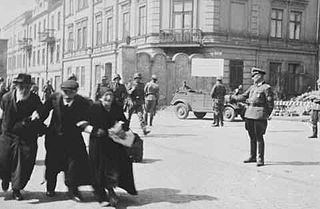Start date 1942 | ||
 | ||
Camp BełżecAuschwitz IIKraków-Płaszów Perpetrators Amon Göth, Julian Scherner, Odilo Globocnik | ||
Operation Reinhard in Kraków, often referred to by its original codename in German as Aktion Krakau, was a major 1942 German Nazi operation against the Jews of Kraków, Poland. It was headed by SS and Police Leader Julian Scherner from Waffen-SS. The roundup was part of the countrywide Aktion Reinhard (Operation Reinhard), the mass murder of Polish Jews in the so-called General Government under the command of SS und Polizeiführer Odilo Globocnik.
Contents
History
Beginning in 1941, all Jewish inhabitants of Kraków were ordered to relocate into the newly established Ghetto Krakau situated in the Podgórze district, away from the predominantly Jewish district of Kazimierz. A German Labour Office (Arbeitsamt) was set up for those employed outside the Ghetto. At the beginning of 1942, the entire Jewish population of Greater Kraków (including 29 surrounding villages) was forced to move into the same Ghetto with each person granted 4 cubic meters (140 cu ft) of space. On 1 June 1942 the ghetto was surrounded by German police and SS. To conceal the purpose of the "Aktion" and calm the Jewish population, the SD and SiPo officers – among them SS-Obersturmbannführer Willi Haase, SS-Obersturmführer Becher, and SS-Hauptscharführer Heinrich – told the Jews of a "resettlement" programme. Jews who worked in German factories were permitted to remain, while the first transport of 7,000 Jews were assembled on Zgody Square and escorted to the railway station in Prokocim. On 5 June 1942 additional 4,000 Jews were deported to Bełżec extermination camp in a similar way.
On 13 March and 14 March 1943, the Nazis carried out the final 'liquidation' of the ghetto under the command of SS-Hauptsturmführer Amon Goeth. Those deemed able to work were transported to the Kraków-Płaszów concentration camp. Some 2,000 Jews unable to move or attempting to run were killed in the streets and in their homes. The captives were sent to Auschwitz. As noted by historians Ernst Klee, Willi Dressen and Volker Riess, the German police from the office of Grenz Polizeikommissariat were quite eager to take part in the murdering of Jews in and around Kraków, in anticipation of considerable material gains.
Members of the Grenzpolizeikommissariat were, with a few exceptions, quite happy to take part in shootings of Jews. They had a ball! Obviously they can't say that today! Nobody failed to turn up... I want to repeat that people today give a false impression when they say that the actions against the Jews were carried out unwillingly. There was great hatred against the Jews; it was revenge, and they wanted money and gold. Don't let's kid ourselves, there was always something up for grabs during the Jewish actions. Everywhere you went there was always something for the taking. The poor Jews were brought in, the rich Jews were fetched and their homes were scoured.
Enamelware factory
The majority of Jews who survived the 1942–43 Ghetto liquidation programme in Kraków, came from the Deutsche Emaillewaren-Fabrik (DEF) owned by the Moravian-born war profiteer Oskar Schindler. Tipped off to the factory closure, Schindler persuaded the SS officials to allow him to move his 1,200 Jewish workers from the Kraków Ghetto to Brünnlitz (Czech: Brněnec) in Sudetenland, thus sparing them from certain death.
Schindler's factory relocation is not to be confused with the similar evacuation of Przemyśl Jews from deportation to Bełżec. The liquidation of Przemyśl Ghetto took place on July 27, July 31 and August 3, 1942. The operation was directed by SS-Hauptsturmführer Martin Fellenz. On 27 July 1942, the military commander of Przemyśl, Max Liedtke, ordered his troops to seize the bridge across San river that connected the divided city of Przemyśl, and halt the evacuation. The Gestapo were forced to give him permission to retain workers performing service for the Wehrmacht. For the actions undertaken by Liedtke and his adjutant Albert Battel in Przemyśl, Yad Vashem later named them "Righteous Among the Nations". After the Aktion had taken place, Jews in the Ghetto were requested to pay the transportation costs for the so-called 'evacuation'. All of them were deported to Bełżec extermination camp thereafter.
